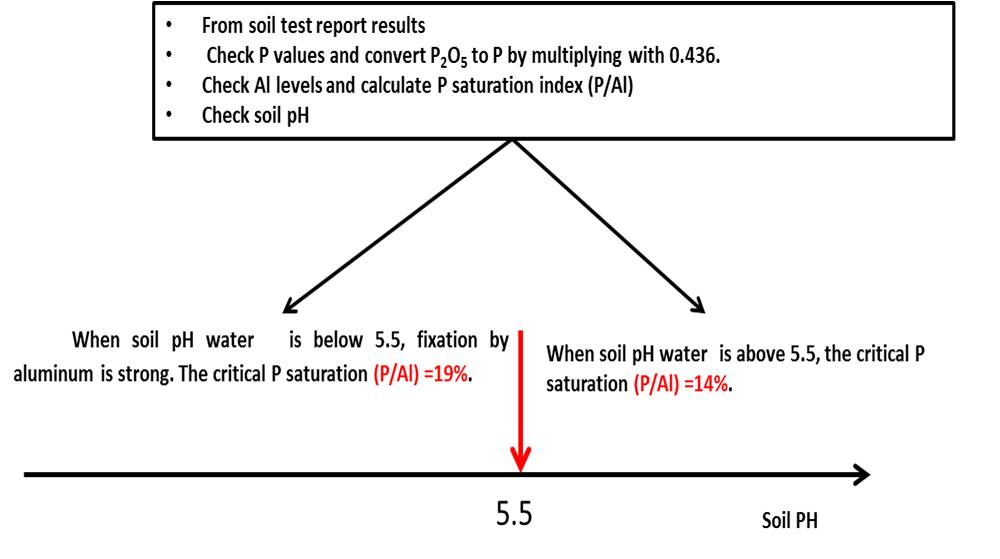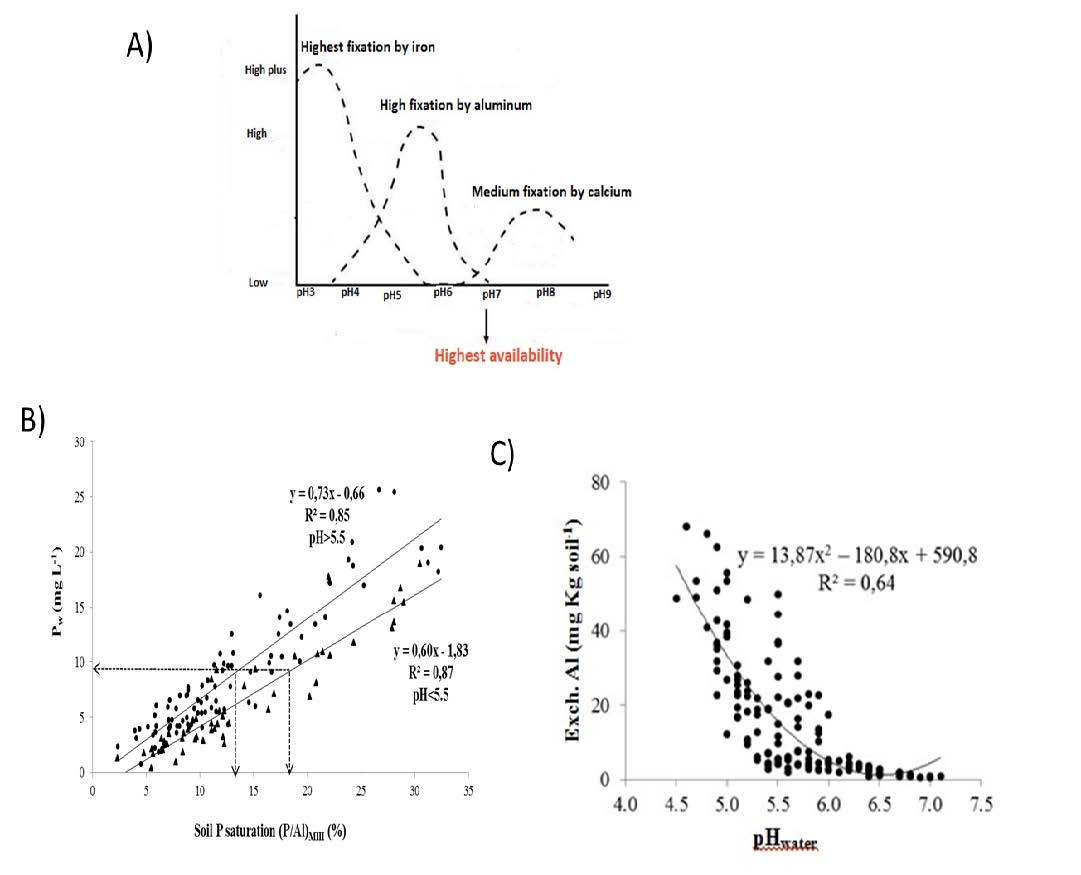Understanding the factors controlling phosphorus availability for crop production on PEI
Phosphorus (P) is a key element in crop production. Phosphorus enhances root growth, flowering, seed formation and seed maturation. Phosphorus availability is controlled by several factors such as soil organic matter levels, soil pH, and soil aluminum and iron contents, making it a challenge to estimate how much P will be supplied to the crop. Additionally, other factors, such as fertilizer placement, can significantly impact P availability during the growing season.
- Fertilizer placement: Since P is quite immobile within the soil profile, fertilizer placement close to the seed (through banding) can increase its availability to the crop. Placement outside of the root zone (such as broadcast) decreases efficient use of P unless roots grow extensively out to where it has been placed. Ensuring P is placed close to the root, while avoiding seed burn, is necessary to enhance P availability to the crop throughout the season.
- Organic matter: Phosphorus uptake can be increased in a variety of different mechanisms dependent on organic matter (OM) levels. Phosphorus, in an organic phosphate form, can form complexes with organic matter. Over time, the P that attached to OM can be displaced by organic anions from the soil solution, effectively increasing P availability to plant roots for uptake. Organic matter (specifically humus) can also coat and interfere with P binding sites, making P more available for uptake by plant roots, rather than being tied up with other nutrients such as aluminum (Al) and iron (Fe) through strong chemical bonds. Finally, P that is already tied up within soil organic matter, can mineralize throughout the season, and will act as a source of P available for crop uptake.
- Soil pH: Phosphorus availability in soils that are acidic in nature, like those found on PEI, can also be restricted by iron (Fe) and aluminum (Al) oxides found naturally within the soil. Fe and Al oxides are the key components of P fixation in acidic soils (Figure 1A). Fixation refers to the binding of P to Fe and Al oxides through strong chemical bonds resulting in reduced “free P” within the soil solution. Therefore, the ratio between extractable P over Al and Fe has been used as an index of P retention. Phosphorus fixation in PEI is more often caused by Al rather than Fe, as fixation by Fe occurs in soils with very low pH (< pH 4.5; Fig. 1A).
Phosphorus fixation is often compensated by applying P rates much greater than the crop P requirements. This can increase the amount of P that could be at risk of loss in instances where runoff can occur. Indices that reflect the extent to which P sorption sites are filled have been developed.
Phosphorus saturation indices can be reliably estimated in acidic soils, using P, Al, and Fe Mehlich-3 test values (Beauchemin and Simard, 1999). The P saturation index (expressed as P/Al) has been used as a basis for P fertilization recommendations in mineral soils for potato crops in New Brunswick (Government of New Brunswick, 2010) and in Quebec (CRAAQ, 2010). Recently, laboratory soil test report results in PEI have included the P/Al ratio to reflect soil P retention, but there is a need to interpret this value in the context of PEI soils. Using selected soil samples from the PEI Soil Quality Monitoring Project soil archive, a P saturation index suitable for PEI soils has been determined.
From this archive, a broad range of 141 soil samples with contrasting P levels were selected and extracted for P and Al using Mehlich-3, water, and ammonium oxalate. Additional basic soil properties were assessed including soil pH, as well as the active form of aluminium (exchangeable Al). The international degree of P saturation (DPS) threshold level obtained with ammonium oxalate as the soil extractant by Breeuwsma and Silva (1992) was used as a reference, and a corresponding value obtained using water as extractant was derived to select a critical level suitable for PEI soils. The DPS index has been recognized as the first indicator of soil P release capability from soil, and was originally developed for acidic sandy soils in the Netherlands, while extractable P represents a simpler index to reflect potential P loss in runoff and is applicable to all soils (Sharpley et al., 2007). The critical level identified with water as extractant was, in turn, correlated with the P saturation (P/Al) ratio using the common Mehlich-3 extractant in acidic soils.
The strength of the relationship between the critical level obtained with water as an extractant and the P saturation level (P/Al, with P and Al extracted with Mehlich -3) was improved when soils were separated based on soil acidity (Figure 1B). Therefore, the soil dataset was divided into two categories; soils above a pH of 5.5 and below a pH of 5.5 (Table 1). Additionally, it was observed that exchangeable aluminium was increasing as the pH decreased below 5.5 (Figure 1C). Basic information on the soil test reports such as soil pH, and Mehlich-3 extracted P and Al can give an idea about the prevalence of exchangeable Al (which precipitates P, thus decreasing its availability), especially when soil pH is around 5.5 (Table 1).
Table 1. Steps to calculate P saturation index from soil test report results

Based on soil pH levels for PEI soils, potential for P transport increases at the critical P saturation levels of 19% (pH < 5.5) and 14% (pH > 5.5) (see Table 1). These threshold levels represent the environmental P indices to evaluate the risk of P loss from fields treated with manures and fertilizers. Using PEI soil data (from 2003 to 2015) collected under the PEI Soil Quality Monitoring project, it resulted that 16% of PEI soils sampled had a P index (P/Al) > 19%, 15 % of soils have 14 > P index ≤ 19%, and 69% of soils have P index ≤ 14%.
To prevent yield loss in low P fertility fields, while limiting environmental risk from P enriched fields, an environmental P index has to be coupled with an agronomic P threshold level above which crop response to P fertilizer is unlikely. An agronomic P threshold level for potato crops is being assessed from 2013 field trial data initiated in PEI, Nova Scotia and New Brunswick to evaluate potato response to increasing P applications rates. The results would serve as a basis to refine P fertilizer recommendation in potato production based on P saturation index, and analysis is currently ongoing.
Figure 1

- Phosphorus fixation by iron, aluminum and calcium in relationships with soil pH. Adapted from Michigan State University - The peaks and valleys of phosphorus fixation .
- Critical P saturation levels in soil by grouping the soils based on soil acidity in 141 PEI samples.
- Exchangeable Al level in 141 PEI soil samples as related to soil acidity.
This factsheet was prepared by Judith Nyiraneza (Charlottetown Research and Development Centre of Agriculture and Agri-Food Canada) and Kyra Stiles (Sustainable Agriculture Resource Section of the PEI Department of Agriculture and Land)
For more information, please contact:
Kyra Stiles
Agri-Environmental Development Coordinator
PEI Department of Agriculture
Acknowledgements: Samples analyses were carried out by Rim Benjannet (a Ph.D. student enrolled at Laval University under the supervision of Drs. Lotfi Khiari and Judith Nyiraneza). The project was funded by Agriculture and Agri-Food Canada.
References:
Beauchemin, S. and Simard, R.R. 1999. Soil phosphorus saturation degree: review of some indices and their suitability for P management in Quebec, Canada. Can. J. Soil Sci. 79: 615–625.
Breeuwsma, A. and Silva, S. 1992. Phosphorus fertilization and environmental effects in the Netherlands and the Po region (Italy). Winand Staring centre for integrated land, soil, and water research, agric. Res. Dep. Rep. 57, Wageningen, The Netherlands.39 p.
CRAAQ 2010. Centre de référence en agriculture et agroalimentaire du Québec, 2nd Edition. Fertilization Reference guide (In French). Ste-Foy, Qc, Canada.
Government of New Brunswick, Department of Agriculture, Aquaculture and Fisheries. 2011. Modifications to the soil test reports and new phosphorus fertilization table for potatoes-2011.
Sharpley , A.N., Kleinnam, P.J.A. and J.L. Weld. 2007. Chapt.14. Environmental soil phosphorus indices. In Carter, M.R, and E.d, Gregorich (Eds). Soil sampling and methods of analysis. Can. Soc. Soil Sci., Lewis Publ., Boca Raton, FL.